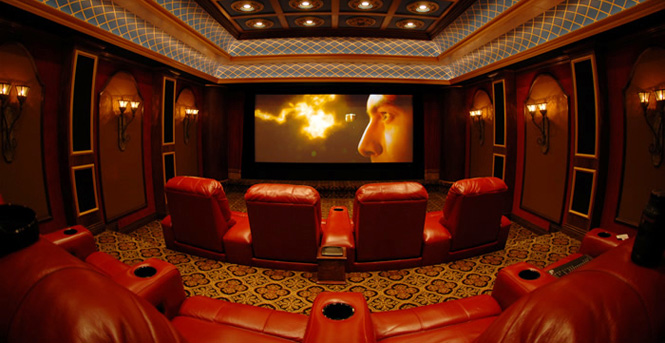
We don’t know about you, but we’re tired of hearing about the economy. Who says you can’t have a little fun during tough times? While building a home theater may not sound like the most prudent idea, you can do it for relatively cheap – if you do it yourself! You’ll save money on the cost of an electronic systems consultant, the cost of gear, learn some really cool tricks, and have a blast doing it. Here are a few of our favorite DIY tips for your home theater. Just think of all the money you’ll save never going out to the movies again!
Do It Yourself Screens
Making your own projector screen probably ranks as one of the most hotly discussed topics on the home theater forums. Pros argue over whether or not you need a really high-end, precision-engineered screen to get a great image from your projector. Having worked behind the scenes at a major film screen manufacturer, we know firsthand how much engineering and quality can go into a precision projection screen. But you can make a very decent DIY screen relatively inexpensively if you add a little elbow grease. There are several approaches.

Many DIYers actually build their own screens. You only need wood for the frame, some L brackets, black velvet fabric from the fabric store, a staple gun, and a large roll of white paper (you can find this at the camera store, the kind photographers use as a backdrop for photo shoots). You can also replace paper with “blackout material,” which is a white material used as backing on drapes to keep the sun out, and is therefore very good at bouncing an image back from your projector. Cover the wood in the black velvet using the staple gun, then attach L brackets to keep the frame together. Finally, put the fabric or paper against the back of the screen and staple. Make sure you use even tension throughout so you don’t have little wrinkles in your screen – it’s distracting.
 Acoustic Treatments & Soundproofing
Acoustic Treatments & Soundproofing
Why spend a bunch of money on acoustic absorbers, when they are essentially a bunch of foam covered in fabric? Sure, you can get really nice-looking and high-tech treatments, but they are very easy to make yourself. All you need is some acoustic or eggcrate foam, some wood or particleboard backing, your handy staple gun or glue, and some acoustically transparent fabric. Simply cut the foam to fit your wood backing, and cover with acoustically transparent fabric to match your room. Guilford of Maine is a very well-known company that makes acoustically transparent fabric to order. Unsure where to place your acoustic panels? Follow The Mirror Trick found here. For acoustic diffusers, which work great at the back of your home theater, think uneven surfaces. Bookshelves make great acoustic diffusers, used by even the staunchest audiophiles.

Can’t Do It All? Do It Half-Way
If you feel uncomfortable going full throttle and doing everything by your lonesome, you can still get some help without relying on the full services of a custom installer. For example, Dennis Erskine of Design Cinema Privee offers a custom design plans geared toward the do-it-yourselfer. Erskine will help you plan and design your home theater remotely. You can send him pictures and dimensions of your space via email, and he’ll churn out architectural drawings for things like electrical, framing, elevation, and more. He’ll even give you a complete list of materials needed, arming you with tools before you start putting up studs and drywall. If you want a little installation help, Best Buy’s Geek Squad offers services a la carte, like hanging a flat-panel TV on your wall, which leads us to our next topic.
 Hanging Your Flat-Panel TV
Hanging Your Flat-Panel TV
Flat-panel TVs are heavy, and installing one on your wall can be a headache, but it is worth it if you can pull it off correctly. Again, you can hire someone to do this for you, but it’s not rocket science. Sanus Systems is one company that makes it a little bit easier to do it yourself. First, the company offers a “MountFinder” feature on its website, which lets you search your flat-panel by manufacturer and model number to find a list of mounts that will work with your TV. Then, once you know the mount you are going to use, check out the innovative “HeightFinder” feature, which will tell you exactly where to drill holes for your TV, using that specific mount. Many Sanus mounts, such as those in the VisionMount series, allow you to make post-installation adjustments, which is really convenient. You don’t have to re-hang the plasma or LCD every time you want to adjust its placement. Very cool.
Of course, you will need to make sure you find the studs inside your wall to support the weight of your TV. You can do this easily with a stud finder, which can be purchased for as little as $5 from places like Home Depot. Enlist the help of a friend to help you joist the flat-panel up—these bad boys are heavy!
These are just a few DIY tips that have made our own home theater installation a little easier. Stay tuned for more!
Editors' Recommendations
- Best Samsung TV deals: Save on 4K TVs, QLED TVs, OLED TVs, 8K TVs
- Best Paramount Plus deals: Get your first month free
- Best subwoofer deals: Up the bass for as low as $90
- Best projector deals: Replace your TV with a big screen from $58
- Sony’s best soundbars are reborn as the Bravia Theater Bar 8, Bar 9, and Quad
 Acoustic Treatments & Soundproofing
Acoustic Treatments & Soundproofing Hanging Your Flat-Panel TV
Hanging Your Flat-Panel TV

